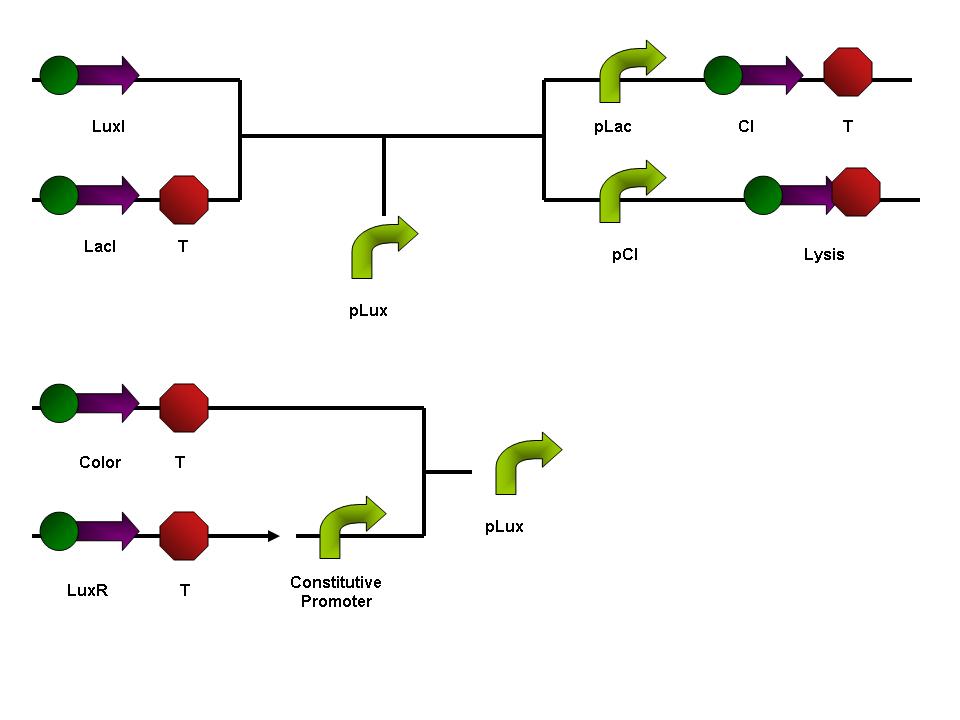Team:Penn State/Project
From 2010.igem.org
(→Genetic Circuit) |
|||
| Line 1: | Line 1: | ||
| + | <html> | ||
| + | <style>#globalWrapper { | ||
| + | background-image: url(http://t1.gstatic.com/images?q=tbn:pkNNff6vnoqKGM:b) !important; | ||
| + | background-repeat: repeat;} | ||
| + | |||
| + | |||
| + | |||
| + | |||
| + | </style> | ||
| + | </html> | ||
| + | |||
| + | |||
<!--- The Mission, Experiments ---> | <!--- The Mission, Experiments ---> | ||
Revision as of 18:45, 27 July 2010
| Home | Team | Official Team Profile | Project | Parts Submitted to the Registry | Modeling | Notebook | Safety |
|---|
Contents |
Overall project
The Penn State Team will be researching and experimenting two different ideas. The first area of study will be creating an oxygen-sensing promoter. This will be done through researching the way that FNR and arcA regulate aerobic/anaerobic respiration in E. coli; engineering applications will be applied to these processes. The second topic we are working on is Bacterial Fireworks, an incorporation of quorum sensing, pigments, and cell lysis. Our goal is to assemble the necessary parts to display the spreading of color as the cells lyse. The team would like to incorporate both aspects of the project to create a bacterial fireworks display that is triggered by a lack of oxygen inside of an agar sphere.
A reliable modular lysis mechanism through quorum sensing could be used in many different fields. As engineered microorganisms are becoming more widely considered for use in the open environment, concerns are growing about possible detrimental effects these microbes could have on ecosystems if they were ever to grow and multiply past expectations. A quorum-based lysis "safety" mechanism would only require one cell to receive a predetermined signal in order to eliminate the entire rogue population, should it escape the area of its intended use.
Project Details
Genetic Circuit
The Penn State iGEM team began work and research in mid May. After learning lab techniques from the grad students, we began researching possible topics. We decided to create a cell lysis device.
Initially, we transformed Lux Promoters, Constitutive Promoters, LuxI + RBS, LuxR + RBS, Lambda Phage lysis devices, Terminators, LacI, LuxR, pLac, CI, RBS, Pigments, FP, LacI + RBS, and CI + RBS.
| Lux Promoters | Lux Promoters | Constitutive Promoters | LuxI + RBS | LuxR + RBS | Lambda Phage Lysis Device | Terminator |
|---|---|---|---|---|---|---|
| [http://partsregistry.org/Part:BBa_K091107 K091107] | [http://partsregistry.org/Part:BBa_R0061 R0061] | [http://partsregistry.org/Part:BBa_J23108 J23108] | [http://partsregistry.org/Part:BBa_C0261 C0261] | [http://partsregistry.org/Part:BBa_J37033 J37033] | [http://partsregistry.org/Part:BBa_K112022 K112022] | [http://partsregistry.org/Part:BBa_B0010 B0010] |
| [http://partsregistry.org/Part:BBa_K091146 K091146] | [http://partsregistry.org/Part:BBa_R0063 R0063] | [http://partsregistry.org/Part:BBa_J23116 J23116] | [http://partsregistry.org/Part:BBa_S01414 S01414] | [http://partsregistry.org/Part:BBa_K112808 K112808] | [http://partsregistry.org/Part:BBa_B1002 B1002] | |
| [http://partsregistry.org/Part:BBa_K145150 K145150] | [http://partsregistry.org/Part:BBa_R1062 R1062] | [http://partsregistry.org/Part:BBa_J23100 J23100] | [http://partsregistry.org/Part:BBa_B1006 B1006] |
| LuxR | LacI | pLac | CI | RBS | Pigment | FP | LacI + RBS | CI + RBS |
|---|---|---|---|---|---|---|---|---|
| [http://partsregistry.org/Part:BBa_C0062 C0062] | [http://partsregistry.org/Part:BBa_C0012 C0012] | [http://partsregistry.org/Part:BBa_R0010 R0010] | [http://partsregistry.org/Part:BBa_C0051 C0051] | [http://partsregistry.org/Part:BBa_B0033 B0033] | [http://partsregistry.org/Part:BBa_K274100 K274100] | RFP + RBS | [http://partsregistry.org/Part:BBa_J24679 J24679] | [http://partsregistry.org/Part:BBa_K081007 K081007] |
| [http://partsregistry.org/Part:BBa_B0034 B0034] | [http://partsregistry.org/Part:BBa_K274004 K274004] | [http://partsregistry.org/Part:BBa_P0451 P0451] |
Our finalized assembly looked like this; however, this would not be the finalization of our project.

The Experiments
Genetic Circuit Assembly
Our second part is a redo of the lysis device.

 "
"